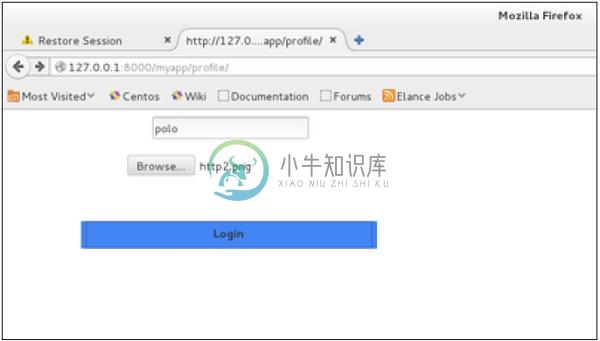Django上传文件
精华
小牛编辑
161浏览
2023-03-14
对于Web应用程序,以便能够上传文件(资料图片,歌曲,PDF格式,文字......),它通常是很有用的。让我们在这一节中来讨论如何使用Django上传文件。
上传图片
在开始开发图片上传之前,请确保Python的图像库(PIL)已经安装。现在来说明上传图片,让我们创建一个配置文件格式,在 myapp/forms.py -
#-*- coding: utf-8 -*- from django import forms class ProfileForm(forms.Form): name = forms.CharField(max_length = 100) picture = forms.ImageFields()
正如你所看到的,这里的主要区别仅仅是 forms.ImageField。ImageField字段将确保上传的文件是一个图像。如果不是,格式验证将失败。
现在,让我们创建一个 “Profile” 模型,以保存上传的资料。在 myapp/models.py -
from django.db import models
class Profile(models.Model):
name = models.CharField(max_length = 50)
picture = models.ImageField(upload_to = 'pictures')
class Meta:
db_table = "profile"
正如所看到的模型,ImageField 使用强制性参数:upload_to. 这表示硬盘驱动器,图像保存所在的地方。注意,该参数将被添加到 settings.py文件中定义的MEDIA_ROOT选项。
现在我们有表单和模型,让我们来创建视图,在 myapp/ views.py -
#-*- coding: utf-8 -*-
from myapp.forms import ProfileForm
from myapp.models import Profile
def SaveProfile(request):
saved = False
if request.method == "POST":
#Get the posted form
MyProfileForm = ProfileForm(request.POST, request.FILES)
if MyProfileForm.is_valid():
profile = Profile()
profile.name = MyProfileForm.cleaned_data["name"]
profile.picture = MyProfileForm.cleaned_data["picture"]
profile.save()
saved = True
else:
MyProfileForm = Profileform()
return render(request, 'saved.htmll', locals())
这部分不要错过,创建一个ProfileForm 并做了一些修改,添加了第二个参数:request.FILES. 如果不通过表单验证会失败,给一个消息,说该图片是空的。
现在,我们只需要saved.htmll模板和profile.htmll模板,表单和重定向页面−
myapp/templates/saved.htmll −
<html>
<body>
{% if saved %}
<strong>Your profile was saved.</strong>
{% endif %}
{% if not saved %}
<strong>Your profile was not saved.</strong>
{% endif %}
</body>
</html>
myapp/templates/profile.htmll −
<html>
<body>
<form name = "form" enctype = "multipart/form-data"
action = "{% url "myapp.views.SaveProfile" %}" method = "POST" >{% csrf_token %}
<div style = "max-width:470px;">
<center>
<input type = "text" style = "margin-left:20%;"
placeholder = "Name" name = "name" />
</center>
</div>
<br>
<div style = "max-width:470px;">
<center>
<input type = "file" style = "margin-left:20%;"
placeholder = "Picture" name = "picture" />
</center>
</div>
<br>
<div style = "max-width:470px;">
<center>
<button style = "border:0px;background-color:#4285F4; margin-top:8%;
height:35px; width:80%; margin-left:19%;" type = "submit" value = "Login" >
<strong>Login</strong>
</button>
</center>
</div>
</form>
</body>
</html>
接下来,我们需要配对网址以开始: myapp/urls.py
from django.conf.urls import patterns, url
from django.views.generic import TemplateView
urlpatterns = patterns(
'myapp.views', url(r'^profile/',TemplateView.as_view(
template_name = 'profile.htmll')), url(r'^saved/', 'SaveProfile', name = 'saved')
)
当访问"/myapp/profile",我们会得到下面 profile.htmll 模板显示 −

在格式提交后,已保存的模板将显示如下 −

这里我们只讲解图片上传示例,但如果想上传其他类型的文件,只需更换 ImageField 在这两个模型及 FileField 表单。
